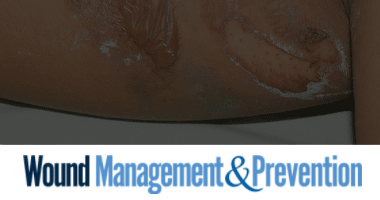Submitted by Janet Wolfson on January 7th, 2023


Submitted by Janet Wolfson on January 7th, 2023

By Heidi Cross, MSN, RN, FNP-BC, CWON

In evaluating a patient with a wound on the foot, a question that often comes to mind is whether that wound is caused by pressure, diabetes mellitus (DM), ischemia, trauma, or a combination. For example, a patient with DM who happens to have an ulcer on the foot may have a diabetic foot ulcer (DFU) or possibly something else. One of the bigger challenges that many clinicians face is trying to determine the etiology of a foot ulcer. There has been a great deal of debate about DFUs and pressure injuries (PIs) on the feet of patients in terms of how to appropriately assess, classify, and treat them. The confusion and lack of evidence in differentiating between these two types of foot ulcers, particularly on the heel, can lead to misdiagnosis, which can increase both financial and patient-related costs … read more
A Collaborative Call for Changes in Reimbursement Policies for pressure injury coauthored by leadership from NPIAP, AAWC and WOCN has been published in the Journal of Patient Safety.
This paper examines reimbursements to improve pressure injury prevention for
CMSGov.
Read the full paper here
Factors to Consider When Determining Wound Etiology
As specialists in wound, continence and ostomy care, we are forever in a role of wearing many hats. We are educators to patients, staff, and providers… we are patient advocates and supporters of our bedside nurses… we are liaisons in many aspects of care and help to coordinate care and services for our patient population. We are often referred to as the specialist and are called upon when there is a patient with a wound, skin, ostomy, or continence concern. Our peers trust us, and it is important that we possess the knowledge and skills to share with others when determining etiology and treatment of wounds and skin issues.
Determining Wound Etiology
An issue we are often faced with as skin specialists is determining the etiology of wounds and skin concerns. When determining the etiology of wounds, it is important to look at the entire picture…and, when doing so, understand that many variables can and do make wounds better or worse, but there is usually an isolated variable that caused the wound.
Medical Device-Related Pressure Injuries
Some things to keep in mind: Pressure injuries are usually round, can appear punched out, may be partial- or full-thickness, may have slough or necrotic tissue, and are usually over a bony prominence. In terms of shape, pressure injuries related to devices usually take the shape of that device (think of a linear, fluid-filled blister from Foley catheter tubing on the thigh… a stage 2 medical device-related pressure injury, or a purple or discolored, non-blanchable area on the lip from an endotracheal tube… a mucosal pressure injury). Other devices that may be responsible for pressure injuries are prosthetic devices … read more
by Dr. Nancy Munoz, DCN, MHA, RDN, FAND
The presence of diabetes can have a negative impact on wound healing rates. Increased glucose levels can stiffen the arteries and contribute to narrowing of the blood vessels. This can influence pressure injury development and is a risk factor for impaired wound healing.
Overview of Diabetes Mellitus
Diabetes is an illness in which the individual’s blood glucose level is above the established range. Glucose is present in the foods we eat. Most foods contain a blend of carbohydrates, proteins, and fats. The amount of each of these nutrients in the foods we consume determines how quickly the body transforms food into glucose. For instance, consuming carbohydrates affects blood glucose levels one to two hours after the meal. Ingesting protein has very little influence on blood glucose levels, and the glucose from the fat in foods is slowly absorbed and does not contribute to increased glucose levels … read more
Is It All About Protein?
by Nancy Munoz, DCN, MHA, RDN, FAND
The National Pressure Ulcer Advisory Panel (NPUAP) defines a pressure injury as localized damage to the skin and/or underlying soft tissue, usually over a bony prominence or related to a medical or other device. The injury can manifest as intact skin or an open ulcer and may be painful. The injury occurs as a result of intense and/or prolonged pressure, occasionally in combination with shear. The tolerance of soft tissue for pressure and shear may also be affected by microclimate, nutrition, perfusion, comorbidities, and the condition of the soft tissue.1
Pathophysiologic and intrinsic factors at the core of pressure injury development include nutrition. Maintaining adequate nutrition is considered a best practice for both the prevention and treatment of pressure injuries … read more
The National Pressure Ulcer Advisory Panel redefined the definition of a pressure injuries during the NPUAP 2016 Staging Consensus Conference that was held April 8-9, 2016 in Rosemont (Chicago), IL.
The updated staging definitions were presented at a meeting of over 400 professionals. Using a consensus format, Dr. Mikel Gray from the University of Virginia adeptly guided the Staging Task Force and meeting participants to consensus on the updated definitions through an interactive discussion and voting process. During the meeting, the participants also validated the new terminology using photographs.
The updated staging system includes the following definitions:
Pressure Injury:
A pressure injury is localized damage to the skin and underlying soft tissue usually over a bony prominence or related to a medical or other device. The injury can present as intact skin or an open ulcer and may be painful. The injury occurs as a result of intense and/or prolonged pressure or pressure in combination with shear. The tolerance of soft tissue for pressure and shear may also be affected by microclimate, nutrition, perfusion, co-morbidities and condition of the soft tissue … read more
ABSTRACT Just over 100 years ago, an article was published describing a plan to treat decubitus ulcers that can shed light upon medical progress and current practices. Key prevention and treatment elements included a dedicated ward, staff continuity, frequent position changes and special surfaces, cleanliness, disinfectants, and dressing changes. The necessity of resource allocation and interdisciplinary collaboration was acknowledged. This article sheds light on not only how much we have learned, but also how far we have to go.
A little over 100 years ago, a Decubitus Division was established at Kings County Hospital in Brooklyn, New York, and a management plan was published in an article in The Hospital Bulletin of the Department of Public Charities of the City of New York.1 This facility was established as an almshouse for the poor and today is a major municipal hospital affiliated with SUNY Downstate College of Medicine and a level I trauma center. We can learn much by examining this century-old plan for preventing and treating bedsores. To understand components of the plan, it must be remembered that antibiotics were decades in the future, and Dakin solution was still being developed on the battlefields of Europe.2 This article uses the terms “decubitus ulcer” and “bedsore,” as the terms “pressure ulcer” and “pressure injury” were not yet in the medical vocabulary.